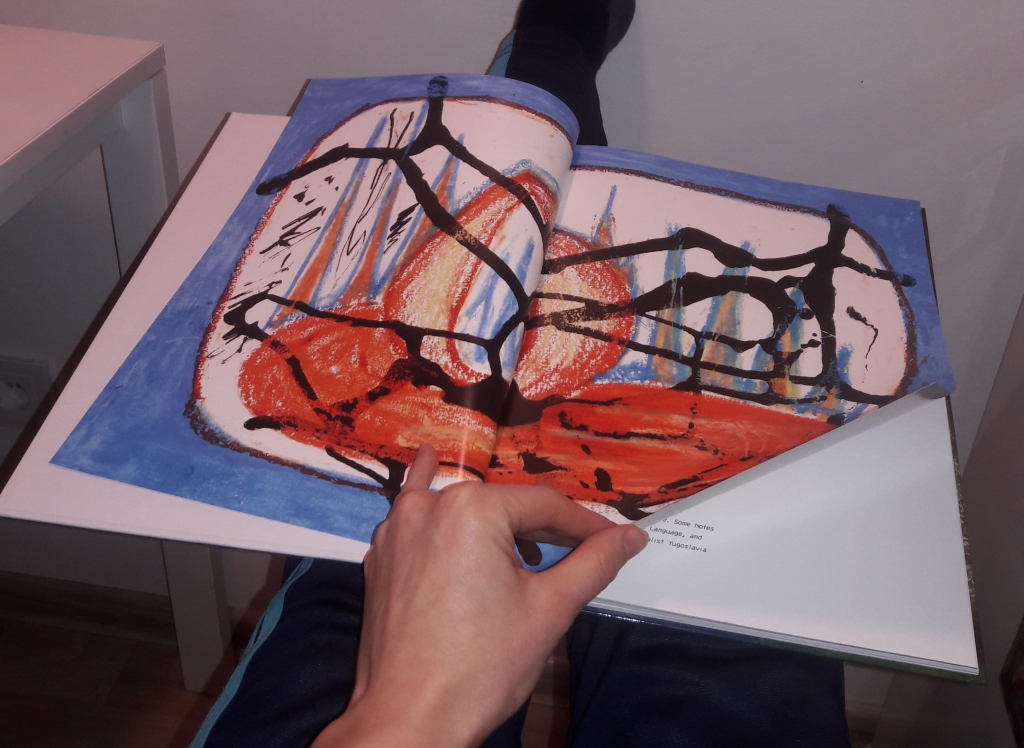
On Friday, 22 March, at 6pm, the Contemporary Art Centre Reading Room (Aušros vartų St. 5/ Pasažo St.) will host a presentation of the publication ‘Aesopica’ by artist Rūta Junevičiūtė. ‘Aesopica’ is a bilingual book documenting and extending upon the artist’s study of the Aesopian language, which was presented in her personal exhibition of the same name in 2020 at the National Gallery of Art and the Rupert Centre for Art, Residencies and Education, both located in Vilnius. During the event, Junevičiūtė will engage in a conversation with researcher and writer Karolina Rybačiauskaite about the publication and its diverse themes, including the poetics of evasion, the risks associated with transparent speech, and social choreographies. They will also discuss the context of the publication, the process of its creation, and more. Additionally, guests will have the opportunity to view Junevičiūtė’s video work ‘Stendhal Syndrome’ (2020, 9’21), which was screened at the exhibition. The video, comprised of footage from the artist’s travels in Southern California, showcases individuals from the artist’s immediate surroundings.
‘You feel like someone watching a film from the nocturnal TV programme alone at home, wishing you were somewhere out there, a figment of your own imagination rather than reality,’ writes art critic Linas Bliškevičius about the video ‘Stendhal Syndrome’ in the cultural magazine ‘7 meno dienos’.
Note: The event will be held in Lithuanian and English, adapting to the needs of the audience.
ABOUT PUBLICATION
The bilingual book ‘Aesopica’ documents and extends Rūta Junevičiūtė’s research on the Aesopian language and the influence of political censorship to contemporary collective body, first presented in 2020 as the eponymous solo exhibition at the National Gallery of Art and as a permanent outdoor installation at the Rupert Art Center, Vilnius.
Taking as a starting point the historical phenomenon of Aesopian language, which was widespread in Lithuanian culture during the Soviet era, and in parts of the Russian Empire as early as the 19th century, Junevičiūtė aims to investigate the interrelationship between generations, the gray zones of collective identity creation and the processes of (un)censoring the archives of our bodies.
Aesopian language – a term coined after Ancient Greek fabulist Aesop (gr. Aísōpos), is a type of cryptic communication system, where a text has several layers of meaning often contradictory to each other and which seek to convey official and subversive hidden meanings simultaneously. It is usually employed under conditions of omnipresent state censorship to communicate officially forbidden or taboo subjects and opinions. As a system it contains three members – an author, a censor, and a reader. It uses various modes of circumlocution and euphemisation, innuendo and poetic paraphrasing, which can also be seen as an aesthetic style. It has been advocated for artistic benefits as poetics of omissions, concealment, and travesty. On the other hand, it has been criticized as a sign of conformity and humiliation. In Lithuania, after the fall of the Soviet Union, it has been popularly regarded as a position of dissent, but such an interpretation received criticism from contemporary scholars. “Such a mode of expression is probably as old as censorship itself” – a historian told us.
The publication consists of the artists’ texts presented in the exhibition ‘Aesopica’,a discussion between Lithuanian academics who studied Aesopian language and the influence of censorship to the cultural forms, thematic essays written for the catalog by art critic Edgaras Gerasimovičius, artist Goshka Macuga and dramaturge Ana Vujanović, and the article by poet, writer, dissident Tomas Venclova, first published in 1983.
‘In a world ablaze with multiple crises, aesthetics are increasingly intertwined with narratives about ethics. Junevičiūtė’s ‘Aesopica’ is a prime example of this multidimensional fusion of ethics and aesthetics. The book not only comprises an intriguing collection of historical texts by both renowned and emerging authors from Central and Eastern Europe, but is also in itself a textual and visual discourse, that extends the author’s exhibition and works into a broader context.’ – curator and writer Valentinas Klimašauskas.
Rūta Junevičiūtė is an artist and researcher who studied art history, visual arts and dance, and choreography at the Vilnius Academy of Arts and the Academy of Theatre and Dance in Amsterdam (SNDO – School for New Dance Development). In recent years, Junevičiūtė has been researching the body as a sentient archive, intergenerationality, and holistic healing processes. Her means of artistic expression oscillate between the performing and visual arts, alongside long-term research and a quest for working methods that serve as alternatives to the burnout patterns ingrained in society.
Karolina Rybačiauskaitė is a researcher and writer. Since 2021, she has taught aesthetics and contemporary art theories at the Lithuanian Academy of Music and Theatre. In 2024, she defended her PhD dissertation, “The Problem of the Reinvention of Practices in I. Stengers Thought”, at Vilnius University. In 2023 and 2022, she was a visiting fellow at Leiden University and KU Leuven (with the ERC project Homo Mimeticus), where she considered the meaning of affective mimesis in the creation of artistic and therapeutic practices. Her research focuses on the problems of ecology and relational practices in the French ontological aesthetic tradition and its contemporary interpretations. As a researcher and writer, Karolina regularly collaborates with various contemporary art institutions and residencies (e.g. Mustarinda (2023), Petrohradska kolektiv and Rupert (2020).
Event duration: ~ 1 hour
During the event, the publication will be available for purchase at the publisher’s price. Cash only.
Text contributors: Alfonsas Andriuškevičius, Edgaras Gerasimovičius, Rūta Junevičiūtė, Goshka Macuga, Anastasia Sosunova, Grėtė Šmitaitė, Tomas Venclova, Ana Vujanović.
Participants of the discussion: Paulius Jevsejevas, Rūta Junevičiūtė, Valdemaras Klumbys, Loreta Mačianskaitė, Martynas Mankus, Julija Reklaitė, Dalia Satkauskytė, Dainius Vanagas.
Language editors: Dangė Vitkienė, Aira Niauronytė, Gemma Lloyd.
Translators: Alexandra Bondarev, Erika Lastovskytė, Justinas Šuliokas, Mantė Zagurskytė-Tamulevičienė, Aistis Žekevičius.
Illustrations: Rūta Junevičiūtė.
Graphic design: Gailė Pranckūnaitė.
Publication is bilingual, in Lithuanian and English, p. 144. Edition: 250.
Publisher: Ariel Ink, 2023.
Partner of the project: National Gallery of Art, Lithuania.
This publication is financed by the Lithuanian Council for Culture, DAS Research Development fund.